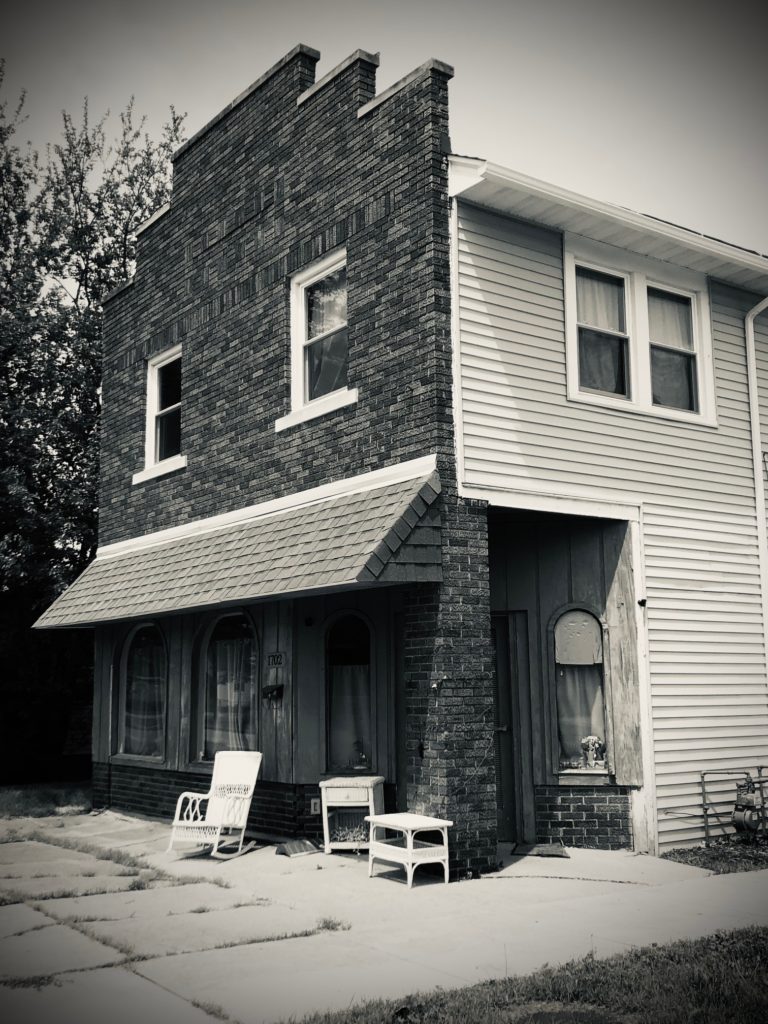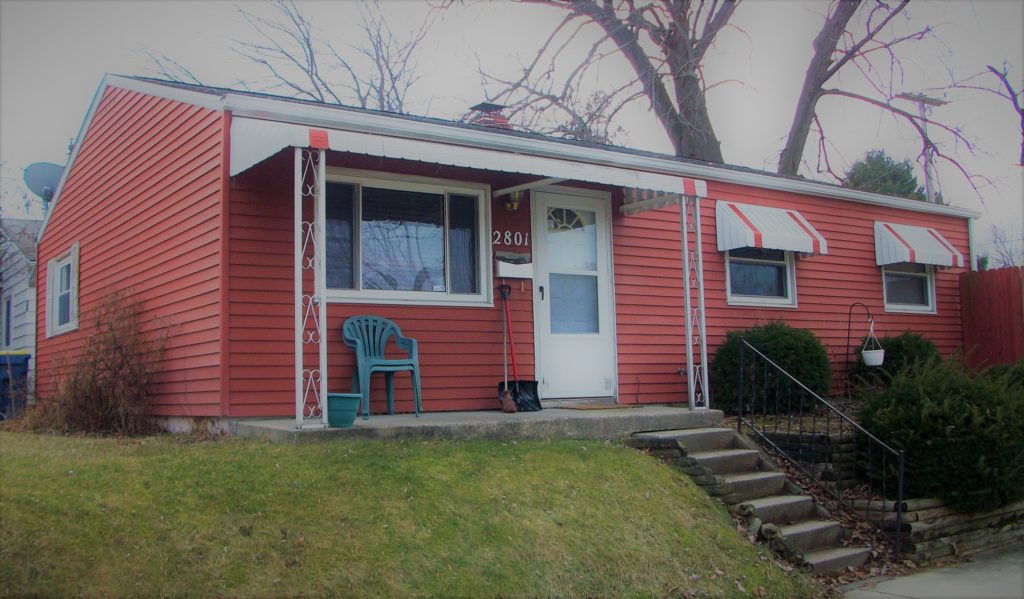Urban Renewal - Evictions and Relocations: 1958 - 1959
The federal government referred to the LaSalle plan as a “Conservation Project,” as the intent was to salvage and preserve as many dwellings as possible. When government officials first assessed the neighborhood, they determined that many of the structures were viable if they underwent some improvements. This was unusual, as most urban renewal projects initiated in the 1950s were not geared toward conservation. At that time, they were more often deemed redevelopment projects, where most residences and outbuildings were demolished without exception. Conservation projects became more prevalent in the mid-1960s, as preservation movements were underway, and citizens were witnessing the aftermath of the destruction of communities from earlier ventures. Emotions ran high, and people applied pressure to the government to find ways to protect some of the targeted areas. Unlike LaSalle, the areas east and south of Dodge Manufacturing (Dodge Park Project, 1960) were parts of a redevelopment project, more informally known as a “clearance project.” The area was deemed hazardous to its inhabitants and nearby residents, and officials determined that much of it was not salvageable. Most of the area was completely razed, with no remnant of the past remaining. Similarly, the areas downtown at the sites of the new U.S. Post Office and Mishawaka Public Library (Civic Center Project, 1966) were also a part of a broader “clearance project.”
For the LaSalle project, the city would require that most of the homes and businesses be renovated. Federal funds were to be used to acquire and demolish properties that were deemed structurally unsound, and the sites were then cleared to make the land desirable for resale and private investment. City officials indicated that they would try to relocate the displaced people to housing within reasonable distance. Overall, the project would cost over $1.5 million (equivalent to over $14 million today), and about a third of it would be funded by the City of Mishawaka. The city’s portion would fund an addition to LaSalle School as well as the South Side Fire Station (located on the southwest corner of Ninth and Wells, demolished ca. 1990). The rest would come in the form of grants from the Housing and Home Financing Agency, which also offered attractive opportunities for builders and lenders to provide low-cost relocation housing for eligible displaced families, including mortgage insurance and lending programs backed by the federal government. The first of these new relocation homes was 2801 Delaware Street (pictured). Of the $1 million in federal grants that were to provide funding to the LaSalle Conservation District, only $5,900 was slated for aid in relocating families.
While the local media reported that residents were in favor of the renewal program and the Southwest Civic Club approved it, former residents who lived through that era do not remember universal approval and complicity from the entire local populace. From the moment that the inhabitants became aware of the program, many residents and politicians would voice concerns throughout the process, which mostly fell upon deaf ears. At the final public hearing, while objections were made, the commission indicated that none of these objections was pertinent to the approval or disapproval of the plan. The Southwest Civic Club praised the work of the city officials who were managing the proposals. While the club feigned ardent approval, descendants of club members say they were acquiescing. No one in Hooligan Heights believed that any of the plans were negotiable, let alone disputable.
Throughout the process, only one part of the plan was formally opposed. What residents found objectionable was the city’s intention to permanently close Delaware Street. The decision to do this was based on “modern” urban planning scholarship at the time. In the mid-twentieth century, planners believed that through traffic in residential areas should only be served by large arterial highways, far from homes. At that time, they believed that this was the best way to keep a neighborhood safe, quiet, and pleasant. Residents of Hooligan Heights clearly disagreed. In late 1959, over 150 residents appeared at a raucous public meeting at LaSalle School to protest the closure. Many were concerned about access to homes and garages that fronted Delaware Street, as well as property values. The meeting quickly became disorderly, and mayor-elect Joseph Canfield had to halt the proceedings to insist on the crowd’s “courtesy” to city planners. While the Southwest Civic Club generally supported the LaSalle plan, their fierce objections here ultimately led the city to reverse their decision and to leave Delaware open. The city council and the planning commission were likely reluctant to draw the ire of the group who they thought were the plan’s biggest advocates.
After the formal communication from city officials regarding the upcoming projects, high-pressure salesmen appeared in both the LaSalle District as well as the Dodge area. Their mission was to convince residents to renovate their homes, to lessen the probability that their dwellings would be acquired and razed. The City of Mishawaka and the redevelopment commission urged citizens to not fall for these ploys, especially in the Dodge district which was planned for clearance. They cautioned residents that this would only incur additional expenses for the homeowner that could never be recovered, as outcomes were not likely to change. Officials informed residents that an expert from the redevelopment commission would contact homeowners and inform them of appropriate renovations and financing if their home was suitable for retention.
By late spring of 1960, the city’s appointed Rehabilitation Director, Zano Vannoni, went door-to-door to assess home renovations with owners who voluntarily agreed to implement improvements to their homes. Working out of the urban renewal office at 1702 Milburn Boulevard, his task was to visit six hundred homes in the area. His role was to assess whether the properties were “standard” or “substandard.” If the building was substandard, he would attempt to work out a program with the owners. If rehabilitation would cost more than the value of the home, he would advise them not to make the repairs. In his work, he would assist with improvement plans, help families to acquire loans, help them to select contractors, and advise on building codes. That summer, he had already counseled over one hundred homeowners on upgrades that would be mandated, if necessary. Vannoni had a building inspector reporting to him who was efficient and productive, but by October the city had to hire an additional inspector to keep pace with the considerable workload.

The first federal grant for the LaSalle District was provided to Mishawaka in early June 1960. This money, $277,000, would allow the redevelopment commission to start acquiring parcels that were to be cleared. After the funding arrived, “blighted” properties were condemned, and the commission could start making offers to proprietors. Many homeowners immediately took the city’s offers or negotiated quickly, either hoping for a better living situation or realizing the futility of resistance. John Sherbun, the commission’s relocation specialist, started finding homes for people immediately, and some were relocated within weeks of having their properties condemned and acquired. Families were given $200 for the move and would be granted two months of rent-free living at their appointed location. On July 13, 1960, at 7:00 PM, the City of Mishawaka began formally taking bids from construction companies to demolish over one hundred homes and commercial buildings in Hooligan Heights. Not one street in the neighborhood would be left unscathed.
While many families complied with the city’s demands to renovate or vacate their properties, the clearance and forced rehabilitation efforts underwent criticism by many citizens and even from some members of the city council. Outcry from the citizens who were most affected and did not want to lose their homes was not captured in the local newspapers. Some current and former residents who lived through that period recall the despondency and sadness of the community during that time.
Many of the people who were forcibly removed were impoverished, and some of the evicted people who lived on Panama Street were overcome with grief. Witnesses say that neighbors were horrified as they watched the local government condemn properties and remove residents, even if they were compensated for it. Even if a resident’s home was not to be condemned, many were angered by having to let officials inspect their property and then order them to make changes. The locals then watched in disbelief as the Mishawaka Fire Department set fire to condemned homes and held practice drills where neighbor families once resided. Former inhabitants indicated that it was an emotional struggle for many in the community.

While the city never considered halting the plan, officials were aware of the fact that they had to formulate appropriate messaging to avert a public relations disaster. In July 1960, John Sherbun and Zano Vannoni held a public meeting to discuss the sociological impacts of the renewal as an attempt to humanize the affected individuals. Sherbun indicated, “We have some neighborhoods which may be called slums because the buildings may be substandard. But the people are not substandard – they are fine people – and their homes are very well kept, neat and clean.” He went on to explain that the biggest issues are not with those considered “undesirable,” but with the aged. Over 50% of those to be relocated were over 50 (“aged or aging”). He went on to say that the biggest problem with this contingent is that they have financial challenges and are resistant to change. He was clear that many of these “elderly” who were to be relocated were given direction and options for help: marriage counselors, the Family and Children’s Center, the Welfare Department, and the St. Joseph Project on the Aged and Aging. Vannoni was clear that the rehabilitation programs would eliminate slums and blight and ensure that new slums were not formed throughout the city. “When a homeowner improves his home,” Vannoni said, “it helps him, it helps the neighborhood, and it helps the city. All benefit from the rehabilitation program.” While trying to plead a case for the benevolent and humanitarian aspects of urban renewal, the success of the city’s outreach was dubious, at best.
By early 1961, at least one city council member was openly criticizing the inspections process for the LaSalle project. Vannoni did not accept these criticisms, referring to the work as a “free architectural service.” He cited “amazing cooperation” from the dwellers in the LaSalle district, which was evidenced by all the construction that had been completed in the past year. Of over 1,000 homes that were inspected, he indicated that only 19 households had refused to let the city inspect their homes. However, he did not comment on how many expressed reluctance, frustration, or despondence over the process. While not providing any specific numbers, the inspection crew did indicate that many objections were coming from people who owned new homes (built in 1950 or after). About 250 homes in the area met this criterion, and many of their owners were not receptive to this new scrutiny after investing in a new home. Vannoni continued to cite the success of his efforts, stating that the once-blighted LaSalle area “is now becoming one of the best neighborhoods in town.” In Mishawaka in 1960, 38% of all new homes, 25% of all expenditures for new homes, and 25% of expenditures in renovations were spent in the LaSalle area.
Inspections were conducted from prepared formal documents, which included checkpoints for the home as sell as questions about occupants’ income and upkeep expenditures. Two different forms were used: one for older homes and one for homes built after 1950. After the surveys, the urban renewal office notified residents who had code violations. Minor violations were sent a list of “strongly recommended” improvements, while major violations called for a summons to a conference. After a period of time, the inspections crew would return to ensure that improvements were made to the properties. Initially, if the improvements were not made, Vannoni himself would visit the residents and would keep it amicable: “The people know they are not being threatened but the program is for their own good and the good of the city.” As time went on, these amicable “recommendations” would become mandated requirements, and the instructions would become more demanding, until forcible removal with legal backing.
Of the 869 dwellings in the renewal zone, 438 homes were refurbished, 117 land parcels were acquired, 88 homes were demolished, and 80 families were relocated.

